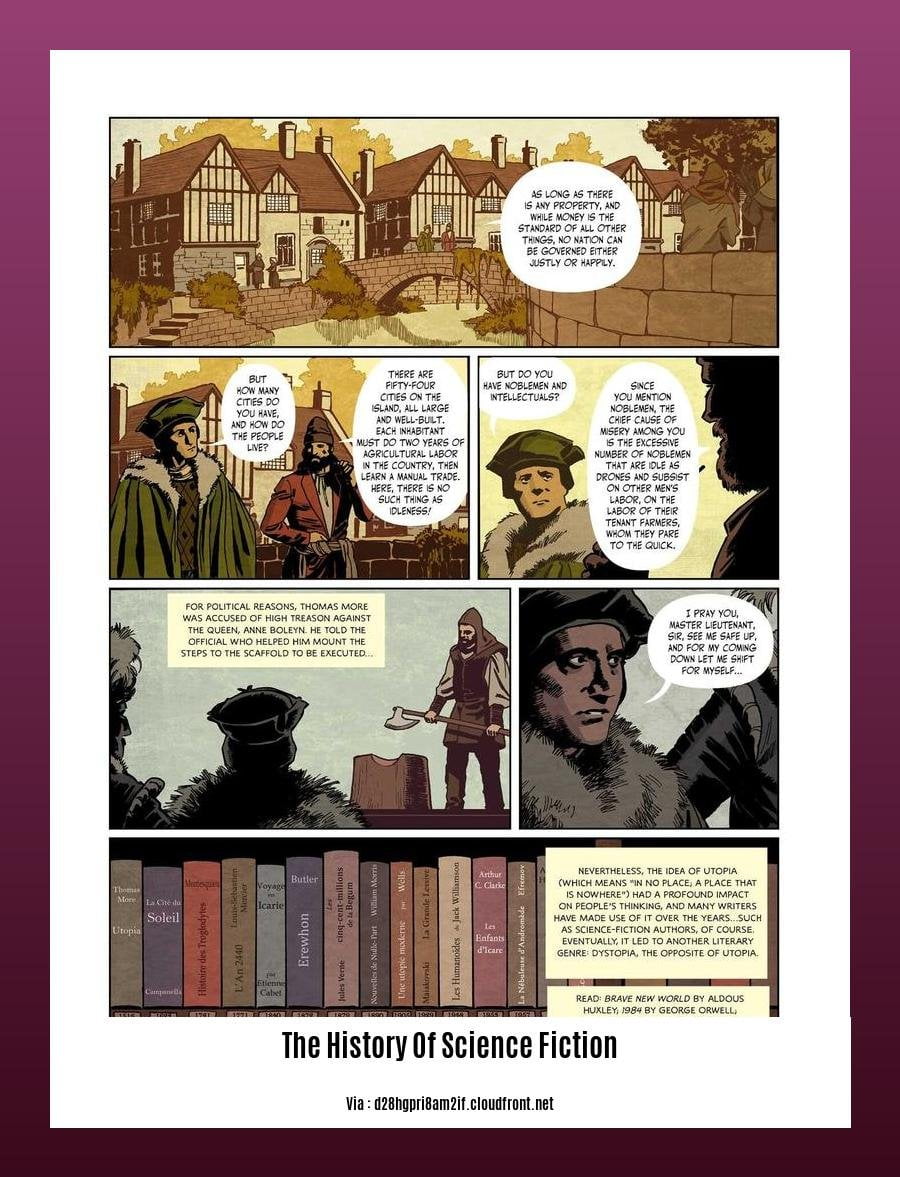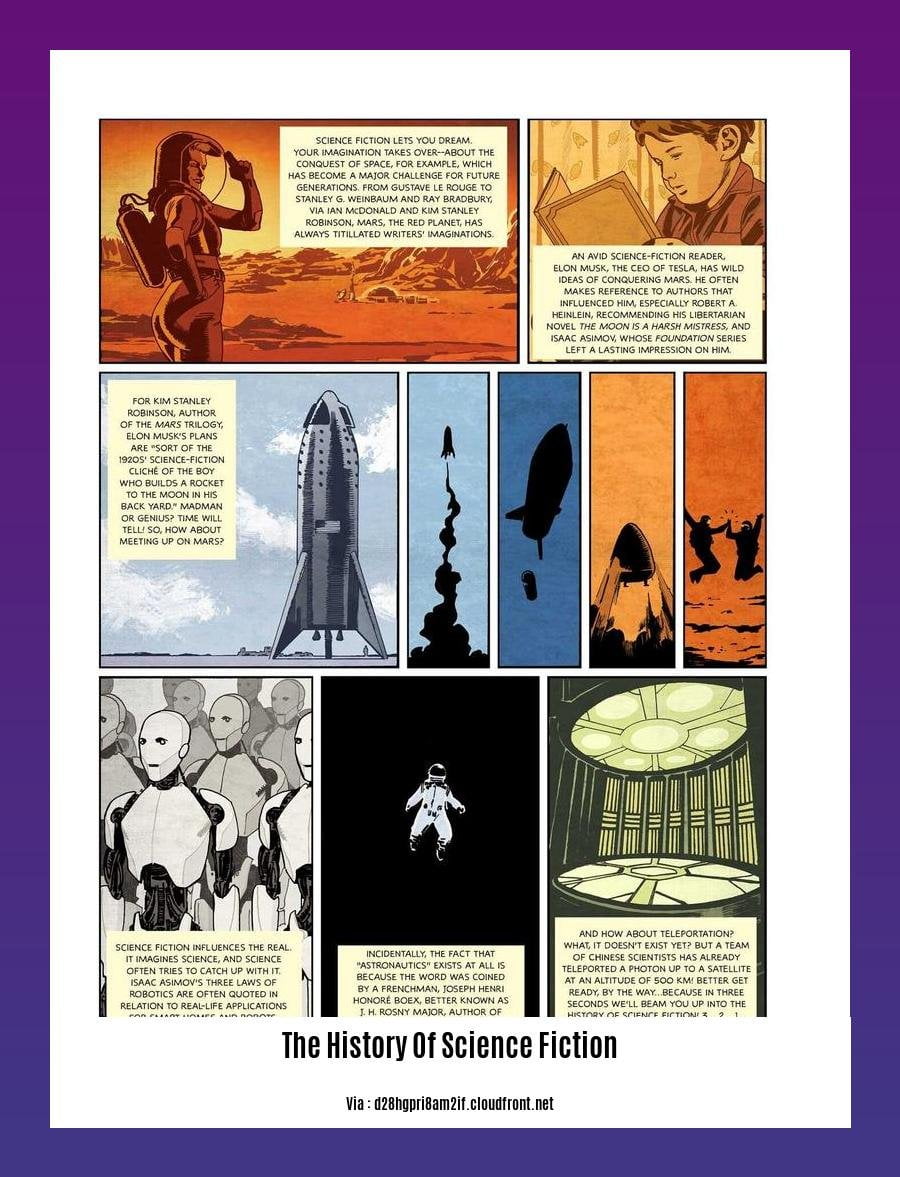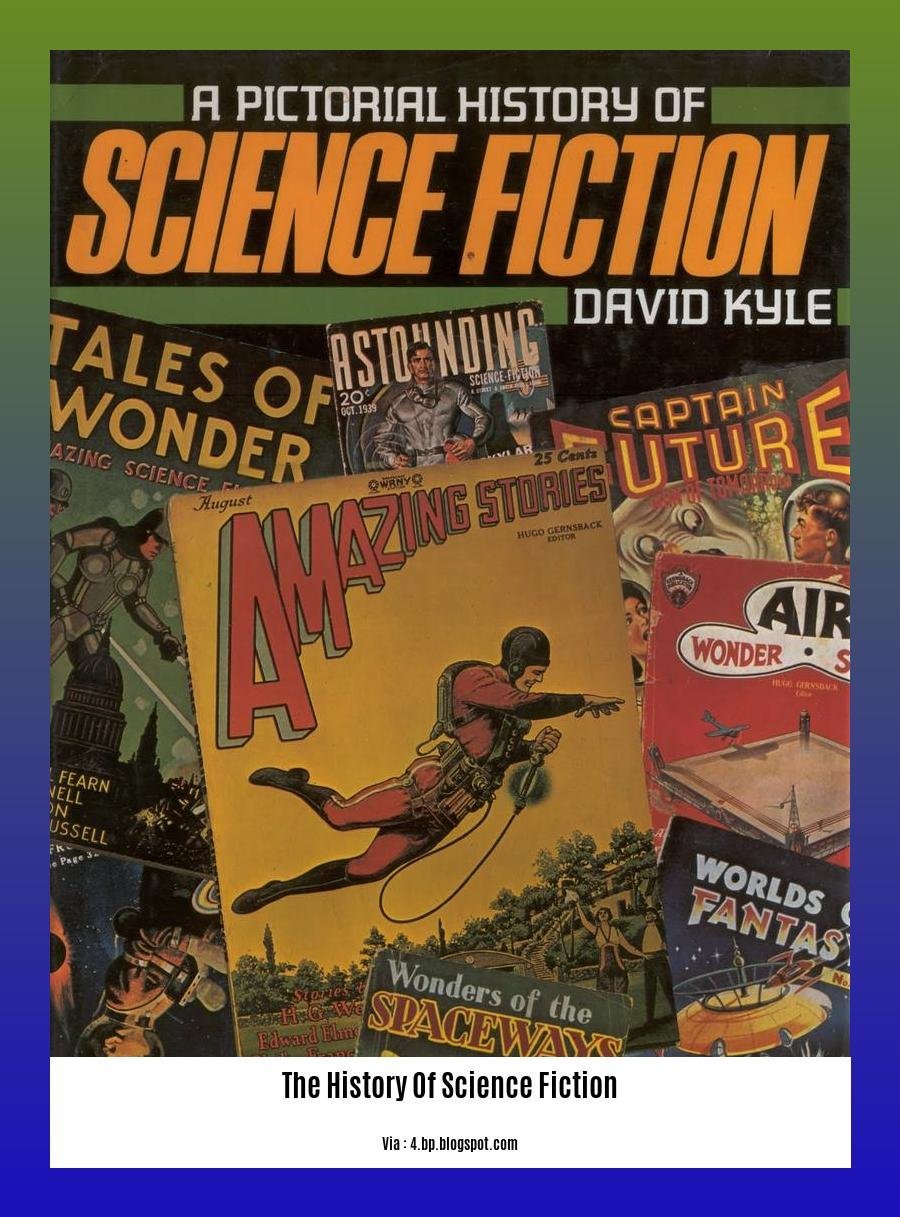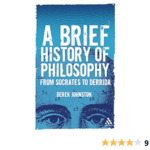Embark on an extraordinary odyssey through the cosmos of imagination as we delve into the captivating history of science fiction, a genre that has transcended the boundaries of reality and shaped the contours of popular culture. From its humble origins in the literary realm to its triumphant ascent on the silver screen and beyond, science fiction has woven a rich tapestry of stories that have ignited our imaginations and propelled us toward uncharted horizons of thought.
Key Takeaways:
The history of science fiction traces its roots back to ancient tales and myths, evolving through the centuries into a distinct literary and cultural phenomenon.
The term “science fiction” was coined in 1851 by William Wilson, and the genre gained significant momentum during the 19th and 20th centuries.
The golden age of science fiction, characterized by iconic authors like Isaac Asimov, Arthur C. Clarke, and Ray Bradbury, flourished in the 1950s.
Science fiction has profoundly influenced other creative genres, including fantasy and horror, blending elements of scientific exploration, imagination, and social commentary.
The reach of science fiction extends beyond literature, encompassing film, television, video games, and other forms of popular culture.
The History of Science Fiction: Where Imagination Meets Reality

Science fiction, a boundless realm where imagination reigns supreme, has left an indomitable mark on our cultural landscape. Embark on an enthralling journey as we delve into the rich history of this genre, a testament to human ingenuity and the boundless power of storytelling.
The Dawn of Wonder: Ancient Roots and Early Influences
The seeds of science fiction were sown in the fertile soil of ancient mythology, where fantastical tales of gods, heroes, and extraordinary creatures ignited the human imagination. These early narratives sowed the seeds of science fiction, setting the stage for a genre that would flourish in centuries to come.
The Golden Age: A Galaxy of Visionaries and Masterpieces
The 1950s marked a golden age for science fiction, an era when visionary authors like Isaac Asimov, Arthur C. Clarke, and Ray Bradbury unleashed a torrent of groundbreaking works. These pioneers pushed the boundaries of storytelling, crafting tales that explored the depths of space, the mysteries of time travel, and the complexities of artificial intelligence.
Beyond the Galaxy: Expanding Horizons in the Modern Era
Science fiction continues to flourish in the 21st century, with a diverse array of authors weaving intricate tales that reflect the complexities of our modern world. From dystopian visions of the future to mind-bending explorations of alternate realities, contemporary science fiction delves into the profound questions of human existence, technology, and the vast mysteries of the cosmos.
The Enduring Impact of Science Fiction: Shaping Our World
Science fiction has played a pivotal role in shaping popular culture and society, extending its influence far beyond the realms of literature. It has inspired generations of scientists, engineers, and innovators, fueling advancements in technology and propelling us toward a future where science and fiction blur.
From captivating films to immersive video games and thought-provoking television series, science fiction has left an indelible mark on our collective consciousness. It has ignited our imaginations, challenged our perceptions of reality, and opened our minds to the boundless possibilities that lie ahead.
Want to know about the development of Western music? Dive into our comprehensive record of the history of Classical music, which explores its evolution from ancient chant to the captivating melodies.
Interested in how those sweet treats came to be? Take a bite out of the history of cookies, where you’ll munch on delicious stories of how these delightful bites became the world’s favorite treat.
Ever wondered how ping pong became a worldwide phenomenon? Rally over to the history of Table Tennis and discover the fascinating journey of the sport, from its humble origins to its status as an Olympic favorite.
The New Wave Movement: Pushing Boundaries and Challenging Conventions

Science fiction (Sci-Fi) has undergone many transformations since its inception, with the New Wave movement standing as a pivotal moment in its evolution. This movement, active in the 1960s and 1970s, heralded an era of experimentation and innovation that challenged traditional conventions.
The New Wave writers, armed with a thirst to break free from established norms, aimed to push the boundaries of Sci-Fi. They embraced experimentation with form, content, and style, weaving in influences from other literary genres like modernism and the avant-garde.
Characteristics of the New Wave Movement:
Experimentation: Breaking free from traditional narrative structures, New Wave authors employed innovative techniques like stream-of-consciousness, unreliable narrators, and non-linear timelines.
Diverse Themes: New Wave writers explored psychological and sociological themes, delving into the human condition, the effects of technology, and the complexities of social change.
Social Commentary: The movement was marked by a strong current of social commentary, addressing real-world issues like the Cold War, the Vietnam War, and the rise of counterculture movements.
Challenging Language: New Wave authors weren’t afraid to challenge traditional literary norms, using unconventional language, syntax, and imagery to create a distinctive voice.
Impact of the New Wave Movement:
Genre Expansion: The movement expanded the scope of Sci-Fi, incorporating elements from other genres like fantasy, horror, and literary fiction.
Influence on Counterculture: The New Wave aligned with the counterculture movement of the time, reflecting a spirit of rebellion and a desire to challenge societal norms.
Legacy in Contemporary Sci-Fi: The experimental spirit of the New Wave continues to influence contemporary Sci-Fi, with many modern authors drawing inspiration from its legacy.
Key Takeaways:
Experimentation: New Wave writers pushed the boundaries of form and content, experimenting with narrative structures, themes, and language.
Social Commentary: The movement addressed real-world issues, using Sci-Fi as a vehicle for social commentary.
Legacy: The New Wave movement’s experimental spirit continues to influence contemporary Sci-Fi, leaving a lasting impact on the genre.
Sources:
New Wave Science Fiction Definition and Literary Examples
New Wave Science Fiction
Science Fiction and the Rise of Dystopian Visions
The darker side of science fiction, dystopian fiction explores the negative consequences of scientific advancements and societal issues, painting a chilling picture of a world gone wrong.
The Birth of Dystopian Science Fiction
Dystopian science fiction emerged in the early 20th century, with authors like H. G. Wells and Yevgeny Zamyatin laying the foundation for this genre. Wells’ “The Time Machine” (1895) introduced the idea of a future world divided into two classes, the Eloi and the Morlocks, a cautionary tale about the potential consequences of class inequality. Zamyatin’s “We” (1921) presented a vision of a totalitarian society where individuality is suppressed and citizens are reduced to mere numbers.
Dystopian Masterpieces: “1984” and “Brave New World”
In the mid-20th century, two dystopian masterpieces redefined the genre: George Orwell’s “1984” (1949) and Aldous Huxley’s “Brave New World” (1932). Orwell’s novel depicted a totalitarian regime where the government controls every aspect of life, using surveillance and propaganda to maintain its power. Huxley’s work presented a society where pleasure and technology are used to pacify the population, leading to a loss of freedom and individuality.
Environmental Concerns and Dystopian Narratives
In the 1970s, environmental crises became a dominant theme in dystopian fiction, reflecting growing public concern about pollution and climate change. Novels like J.G. Ballard’s “The Drowned World” (1962) and Ursula K. Le Guin’s “The Dispossessed” (1974) explored the consequences of environmental degradation and the struggle for survival in a damaged world.
Contemporary Dystopian Fiction: Reflecting Modern Fears
In the 21st century, dystopian fiction continues to thrive, often reflecting the fears and anxieties of the modern world. Suzanne Collins’ “The Hunger Games” series (2008-2010) portrays a totalitarian society where children are forced to fight to the death for survival, highlighting the dangers of authoritarianism and violence. Margaret Atwood’s “The Handmaid’s Tale” (1985) depicts a patriarchal society where women are stripped of their rights and forced into sexual servitude, a chilling exploration of gender oppression and religious extremism.
Key Takeaways:
- Dystopian science fiction explores the negative consequences of scientific advancements and societal issues.
- Early dystopian novels include “1984” by George Orwell and “Brave New World” by Aldous Huxley.
- Dystopian fiction often reflects the fears and concerns of society at the time of its creation.
- In the 1970s, environmental crises became a dominant theme in dystopian fiction.
- Dystopian literature continues to be popular in the 21st century, with recent examples including “The Hunger Games” series and “The Handmaid’s Tale.”
Sources:
– https://www.jamiefosterscience.com/what-is-the-relationship-between-science-fiction-and-dystopia/
–
Contemporary Science Fiction: Reflecting Current Issues and Embracing Diversity
Modern science fiction (SF) reflects the present, delving into themes like climate change, social justice, and technological advancements. It embraces diverse perspectives, recognizing the richness of different cultures and experiences.
Key Takeaways:
- Contemporary SF portrays complex characters, challenging traditional stereotypes.
- It provides fresh perspectives on classic SF themes, revitalizing the genre.
- Diverse voices bring authenticity, depth, and nuance to SF narratives.
- Modern SF tackles real-world issues, encouraging critical thinking and societal dialogue.
- Inclusivity expands the scope of SF, making it more accessible and relatable.
In the past, SF often focused on white, male protagonists, perpetuating limited representations. Today, diverse characters—women, people of color, LGBTQ+ individuals—take center stage, offering multifaceted viewpoints.
Moreover, contemporary SF explores underrepresented settings, moving beyond Westernized narratives. It delves into unique cultures, histories, and mythologies, enriching the genre’s tapestry.
In essence, modern SF embraces the power of diversity, recognizing that different experiences and perspectives lead to more profound and resonant stories.
Sources:
- Science Fiction and Diversity
- The Importance of Diversity in Science Fiction and Fantasy
FAQ
Q1: How did the term “science fiction” originate?
A1: The term “science fiction” was first coined in 1851 by William Wilson, a Scottish journalist, and publisher, who utilized it to describe a genre of literature that combined scientific knowledge with imaginative storytelling.
Q2: What period is considered the “Golden Age” of science fiction?
A2: The 1950s is widely regarded as the “Golden Age” of science fiction, characterized by the emergence of prominent authors such as Isaac Asimov, Arthur C. Clarke, and Ray Bradbury, who produced iconic works that significantly shaped the genre.
Q3: How has science fiction influenced other literary genres?
A3: Science fiction has left a profound impact on other genres, particularly fantasy and horror, by introducing innovative concepts and themes that challenged traditional boundaries and expanded the realm of imaginative storytelling.
Q4: In what ways has science fiction been adapted beyond literature?
A4: Science fiction has transcended the boundaries of literature and found expression in a variety of other media, including film, television, video games, and graphic novels, captivating audiences through visually stunning adaptations and interactive experiences.
Q5: How has science fiction evolved in recent times?
A5: Contemporary science fiction has embraced diversity and inclusivity, incorporating perspectives from underrepresented groups and exploring historical contexts beyond the traditional focus on the future, resulting in a richer and more nuanced genre.














